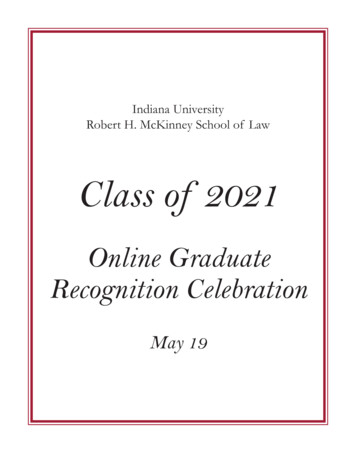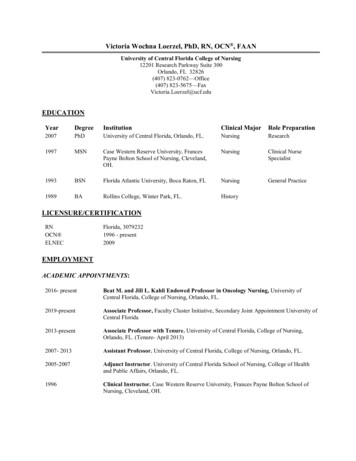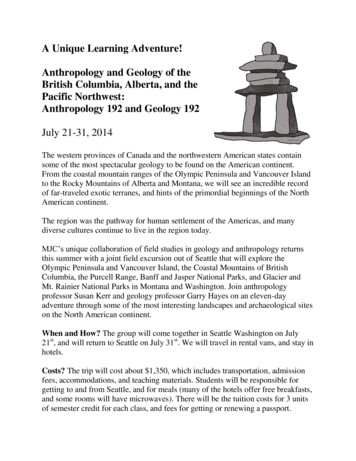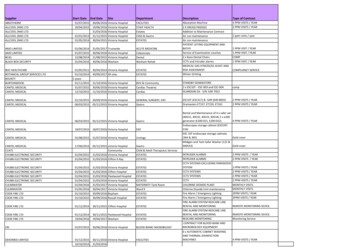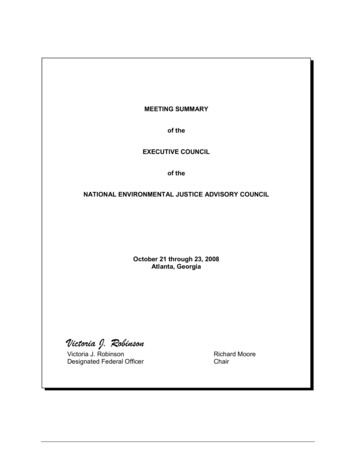
Transcription
MEETING SUMMARYof theEXECUTIVE COUNCILof theNATIONAL ENVIRONMENTAL JUSTICE ADVISORY COUNCILOctober 21 through 23, 2008Atlanta, GeorgiaVictoria J. RobinsonVictoria J. RobinsonDesignated Federal OfficerRichard MooreChair
NATIONAL ENVIRONMENTAL JUSTICE ADVISORY COUNCILEXECUTIVE COUNCILPREFACEThe National Environmental Justice Advisory Council (NEJAC) is a Federal advisory committee that wasestablished by charter on September 30, 1993, to provide independent advice, consultation, andrecommendations to the Administrator of the U.S. Environmental Protection Agency (EPA) on mattersrelated to environmental justice. The NEJAC had 16 members and one Designated Federal Officer(DFO). To date, NEJAC has held twenty five meetings in the following locations: Washington, DC, May 20, 1994Albuquerque, New Mexico, August 3 through 5, 1994Herndon, Virginia, October 25 through 27, 1994Atlanta, Georgia, January 17 and 18, 1995Arlington, Virginia, July 25 and 26, 1995Washington, DC, December 12 through 14, 1995Detroit, Michigan, May 29 through 31, 1996Baltimore, Maryland, December 10 through 12, 1996Wabeno, Wisconsin, May 13 through 15, 1997Durham, North Carolina, December 8 through 10, 1997Arlington, Virginia, February 23 through 24, 1998 (Special Business Meeting)Oakland, California, May 31 through June 2, 1998Baton Rouge, Louisiana, December 7 through 10, 1998Arlington, Virginia, November 30 through December 2, 1999Atlanta, Georgia, May 23 through 26, 2000Arlington, Virginia, December 11 through 14, 2000Washington, DC, August 8 through 10, 2001 (Special Business Meeting)Seattle, Washington, December 3 through 6, 2001Baltimore, Maryland, December 9 through 12, 2002New Orleans, Louisiana, April 13 through 16, 2004Washington, DC, January 5 through 6, 2006 (Special Business Meeting)Washington, DC, June 20 through 22, 2006Baltimore, Maryland, September 18 through 20, 2007Washington, DC, June 10 through 12, 2008Atlanta, Georgia, October 21 through 23, 2008The NEJAC also has held other meetings which include: Public Dialogues on Urban Revitalization and Brownfields: Envisioning Healthy and SustainableCommunities, held in Boston, Massachusetts; Philadelphia, Pennsylvania; Detroit, Michigan;Oakland, California; and Atlanta, Georgia in Summer 1995 Relocation Roundtable, Pensacola, Florida, May 2 through 4, 1996 Environmental Justice Enforcement and Compliance Assurance Roundtable, San Antonio, Texas,October 17 through 19, 1996 Environmental Justice Enforcement Roundtable, Durham, North Carolina, December 11 through13, 1997 International Roundtable on Environmental Justice on the U.S./Mexico Border, San Diego,California, August 19 through 21, 1999As a Federal advisory committee, the NEJAC is governed by all provisions of the Federal AdvisoryCommittee Act (FACA) of October 6, 1972. Those requirements include: Members must be selected and appointed by EPA Members must attend and participate fully in meetings of the NEJAC Meetings must be open to the public, except as specified by the EPA Administrator All meetings must be announced in the Federal Register Public participation must be allowed at all public meetings The public must be provided access to materials distributed during the meeting Meeting minutes must be kept and made available to the public A DFO must be present at all meetings of the NEJAC (and its subcommittees)Atlanta, Georgia, October 21 through 23, 2008i
EXECUTIVE COUNCIL NATIONAL ENVIRONMENTAL JUSTICE ADVISORY COUNCILThe NEJAC must provide independent judgment that is not influenced by special interest groupsEPA's Office of Environmental Justice (OEJ) maintains transcripts, summary reports on the meetings ofthe NEJAC, and copies of material distributed during the meetings. Those documents are available to thepublic upon request.Comments or questions can be directed to OEJ through the Internet. OEJ's e mail address is:environmental justice epa@epa.govExecutive summaries of the reports on the meetings of the NEJAC are available in English and Spanishon the Internet at the NEJAC’s World Wide Web home page: http://www.epa.gov/compliance/environmentaljustice (click on the link to the National Environmental Justice Advisory Council)iiAtlanta, Georgia, October 21 through 23, 2008
NATIONAL ENVIRONMENTAL JUSTICE ADVISORY COUNCILEXECUTIVE COUNCILTable of ContentsTable of Contents. iiiChapter 1 NEJAC Executive Council Discussions .21. 0Welcome and Introductions.22.0Environmental Justice Best Practices Forum.32.1Communities and Indigenous Populations .32.1.1Center for Environmental and Economic Justice .32.1.2Citizens for Environmental Justice.32.1.3Safer Pest Control Project .42.1.4West End Revitalization Association.42.1.5Anahola Homesteaders Council .52.2State and Local Governments .52.2.1County of San Diego Department of Environmental Health.52.2.2New Mexico Environmental Department.62.2.3South Carolina Department of Health and Environmental Control.62.3Non Governmental/Environmental Organizations .72.3.1Communities for a Better Environment .72.3.2Duke University Children’s Environmental Health Initiative.72.3.3Medical University of South Carolina .82.3.4Deep South Center for Environmental Justice at Dillard University .83.0Dialogue with Mr. Granta Nakayama, AA, EPA OECA .94.0NEJAC Work Group Discussions .104.1Good Movement Work Group Presentation .114.2Nationally Consistent Environmental Justice Screening Approach Work Group .134.3Environmental Justice, Green Business, and Sustainability Work Group.144.4State Environmental Justice Cooperative Agreements Work Group .155.0EPA Environmental Justice Program: Historical Lessons and Future Directions Presentation .156.0Differential Impacts of Climate Change Panel.176.1Dr. James Sadd, Professor, Occidental College .176.2Ms. Rona Birnbaum, Branch Chief, EPA Office of Air and Radiation, Climate Science & ImpactsBranch.196.3Chief Peter Captain, Sr., Senior Vice President, Tanana Chiefs Conference .206.4Ms. Wynecta Fisher, Director, City of New Orleans, Mayor’s Office of Environmental Affairs.216.5Mr. Bill Gallegos, Executive Director, Communities for a Better Environment.227.0Factors to Identify and Assess Disproportionate Environmental Justice Impacts Discussion .238.0Closing Statements and Next Steps.26Chapter 2 Summary of Public Comment Period.271.0Introduction .272.0Public Comment Period Held on October 22, 2008 .27Atlanta, Georgia, October 21 through 23, 2008iii
NATIONAL ENVIRONMENTAL JUSTICE ADVISORY COUNCILEXECUTIVE COUNCILNational Environmental Justice Advisory CouncilAtlanta, GeorgiaOctober 21 through 23, 2008Meeting Summary of the Executive CouncilThis summary presents highlights of the 25th meeting of the National Environmental Justice AdvisoryCouncil (NEJAC) Executive Council held October 21 through 23, 2008 in Atlanta, Georgia and the publiccomment period that was held on October 22, 2008.NEJAC is a Federal advisory committee that was established by charter on September 30, 1993, toprovide independent advice, consultation, and recommendations to the Administrator of the U.S.Environmental Protection Agency (EPA or the Agency) on matters related to environmental justice. Mr.Richard Moore, Executive Director, Southwest Network for Environmental and Economic Justice, servesas the Chair of the NEJAC Executive Council. Ms. Victoria Robinson, NEJAC Program Manager, EPAOffice of Environmental Justice (OEJ) is the Designated Federal Officer (DFO) for NEJAC. Exhibit 1 liststhe members of the Executive Council who were in attendance, asExhibit 1well as those who were unable to attend the meeting.OEJ maintains transcripts and summary reports of the proceedingsof the meetings of NEJAC. Those documents are available to thepublic upon request. The public also has access to the executivesummaries of reports of previous meetings, as well as otherpublications of the NEJAC, through the Internet c/meetings.html(select the meeting summaries link).This summary is organized into two chapters. Chapter 1, NEJACExecutive Council Discussions, summarizes the deliberations of theNEJAC and is organized into the following sections: 1) Welcomeand Introductions; 2) Environmental Justice Best Practices Forum; 3)Dialogue with Mr. Granta Nakayama, Assistant Administrator, EPAOffice of Enforcement and Compliance Assurance; 4) NEJAC WorkGroup Discussions; 5) EPA Environmental Justice Program: HistoricLessons and Future Directions Presentation; 6) Differential Impactsof Climate Change Panel; 7) Factors to Identify and AssessDisproportionate Environmental Justice Impacts Discussion; and 8)Closing Statements and Next Steps. Chapter 2, Summary of PublicComment Period, summarizes the public comment period.Atlanta, Georgia, October 21 through 23, 2008NEJAC EXECUTIVE COUNCILMembers in AttendanceMr. Richard Moore, ChairMr. Chuck BarlowMs. Sue BriggumMs. Jolene CatronMr. William HarperMr. Christian HolmesMr. J. Langdon MarshMr. Gregory MelansonMr. Paul MohaiMr. Shankar PrasadMr. John RidgwayMr. John RosenthallMs. Patricia SalkinMr. Omega WilsonMs. Donele WilkinsMs. Victoria Robinson, DFOMembers not in AttendanceMs. M. Kathryn BrownMs. Jodena HennekeMs. Joyce KingMs. Elizabeth Yeampierre1
EXECUTIVE COUNCILNATIONAL ENVIRONMENTAL JUSTICE ADVISORY COUNCILChapter 1NEJAC Executive Council Discussions1. 0Welcome and IntroductionsMr. Charles Lee, Director, U.S. Environmental Protection Agency (EPA or the Agency) Office ofEnvironmental Justice (OEJ), Mr. Richard Moore, Executive Director, Southwest Network forEnvironmental and Economic Justice, Ms. Catherine McCabe, Deputy Assistant Administrator (DAA),Office of Enforcement and Compliance Assurance (OECA), Mr. Granta Nakayama, AssistantAdministrator (AA), OECA, Mr. Russell Wright, Acting Deputy Regional Administrator (DRA), EPA Region4, and Mr. Robert Varney, Regional Administrator, EPA Region 1, provided opening remarks.During his welcoming remarks, Mr. Lee described the need to ensure that the NEJAC continues to moveforward during the transition to a new Presidential administration. He noted that several of thepresentations will address this issue, particularly his comments on the future direction of OEJ.Additionally, Mr. Lee formally announced that Ms. Victoria Robinson, NEJAC Program Manager, EPAOEJ, will serve as the Designated Federal Officer (DFO) for the NEJAC. Mr. Moore congratulated the 12winners of EPA’s first Environmental Justice Achievement Awards, and emphasized the need for theNEJAC to continue to focus on the improvement of communities, adding that the Best Practices sectionwill provide important lessons learned for community betterment. Mr. Wright echoed Mr. Moore’scomments stating that the best practices outlined during this meeting will inform future successes forcommunities nationwide.Ms. McCabe described OECA’s recent enforcement successes, including the installation of 11 million inpollution controls that has resulted in the removal of more than three billion pounds of pollutants. Sheadded that OECA is working on quantifying these reductions in terms of human health impacts,particularly in environmental justice communities. Ms. McCabe noted the importance of integratingenvironmental justice into the Agency’s planning, decision making, and enforcement processes. Over thelast three years, OECA and OEJ have succeeded in building momentum around environmental justice.At the most senior level, EPA has revitalized the Environmental Justice Steering Committee, a collectionof EPA’s senior management (i.e., DAAs and DRAs) who provide oversight and cohesion to the Agency’senvironmental justice efforts. The Agency has added specific environmental justice priorities in theannual National Program Managers Guidance, the Agency’s operation manual. To ensure accountabilityfor environmental justice integration, EPA’s regional and program offices have developed EnvironmentalJustice Action Plans (Action Plans), which outline the environmental justice activities to be undertakenand the anticipated results. With respect to rulemaking, OEJ now participate in the workgroups thatdevelop and design rules and regulation to help ensure that the impacts on environmental justicecommunities are considered during the rulemaking process. In addition, OECA and OEJ have developedquantitative tools such as the Environmental Justice Strategic Enforcement Assurance Tool (EJSEAT) tomeasure disproportionate impacts. She stated that the Agency needs to capitalize on these recentsuccesses and continue to move forward, especially given the upcoming Presidential transition.Mr. Varney described how EPA Region 1 has worked to integrate environmental justice. The regionaloffice has instituted a mandatory environmental justice training for all employees. This training includesboth classroom instruction and community led field trips. Additionally, the regional office is ensuringaccountability by tracking progress and will remain dedicated to addressing environmental justice.Mr. Nakayama affirmed EPA’s continuing commitment to environmental justice and NEJAC’s role as animportant advisory board and added that Administrator Johnson has been impressed with the NEJAC’sability to provide robust and thoughtful advice. Mr. Nakayama attributed this success to the NEJAC’sdedication, diverse viewpoints, and open discussions.Highlights from the follow up discussion included: Ms. Patricia Salkin, Professor, Albany Law School, inquired about how NEJAC can assist in thebenchmarking of environmental justice commitments in the Action Plans. Mr. Lee replied that the2Atlanta, Georgia, October 21 through 23, 2008
NATIONAL ENVIRONMENTAL JUSTICE ADVISORY COUNCIL 2.0EXECUTIVE COUNCILAction Plans are reviewed annually to assess progress. OEJ is working with the regional andprogram offices to better align these commitments to the core planning processes as well asincorporate result oriented measures. In terms of NEJAC’s role to ensure accountability, Mr. Leenoted that the NEJAC, as a Federal advisory committee, is responsible for providingrecommendations. NEJAC can support the development of stakeholder partnerships in order tointegrate the needs of the affected populations into the plans.Mr. J. Langdon Marsh, Fellow, Portland State University, commended EPA for quantifyingenforcement actions in terms of pollution reductions rather than penalty amounts. He acknowledgedthat this is the beginning of a paradigm shift where enforcement actions are reported as direct healthbenefits (i.e., deaths prevented). Ms. McCabe responded that EPA is making progress on calculatingdirect health benefits of Agency actions. For example, EPA has measured the health benefits fromlast year’s ten largest air pollution enforcement cases.Ms. Salkin encouraged EPA to engage local planning agencies on issues relating to environmentaljustice. She suggested that EPA provide training and incentives to encourage such agencies toconsider environmental justice.Environmental Justice Best Practices ForumThe recipients of the first EPA Environmental Justice Achievement Awards (presented on October 21,2008) were invited to provide presentations on best practices based on the experiences and successes oftheir organizations. Presenters were divided into three groups: Communities and IndigenousPopulations, State and Local Governments, and Non Governmental/Environmental Organizations(including Academic Institutions).2.1Communities and Indigenous Populations2.1.1 Center for Environmental and Economic JusticeBishop James Black, Executive Director, Center for Environmental and Economic Justice, Inc. (CEEJ),discussed his work to improve the environmental conditions of the Turkey Creek community, located nearthe Naval Construction Battalion, the Gulfport/Biloxi Airport, and the vacant Gulf Coast Creosote Plant.He described CEEJ’s efforts as an extension of the Civil Rights Movement and explained how CEEJdecided to focus on toxins stored at military bases along the Gulf Coast. As a result of poorly storedAgent Orange containers at the Battalion, dioxin leached into nearby aquifers contaminating a valuablewater source. He described how inadequate oversight and deterioration of the creosote plant led towaste releases that contaminated approximately 15 acres and poisoned fish in local rivers. HurricaneKatrina helped to further spread the contamination.Bishop Black explained that CEEJ began collaborating with Ms. Gloria Tatum, Environmental Scientist,Mississippi Department of Environmental Quality (MDEQ), to address these issues. Ms. Tatum andCEEJ worked with a remediation company, Environmental Management Services of Mississippi (EMS), todevelop a dialogue to exchange information about the contamination and the cleanup process. To raiseawareness of the contamination and its impacts, CEEJ started a community newspaper, spoke on localgospel radio shows, and facilitated door to door discussions. The community newspaper featured articlesfrom community residents and EMS, which provided periodic updates on the cleanup process. Bybuilding awareness and encouraging meaningful involvement, CEEJ was able to bring EMS to the tableto discuss the community’s concerns; however, Bishop Black noted that the responsible parties have yetto engage in an open dialogue with the community.2.1.2 Citizens for Environmental JusticeDr. Mildred McClain, Executive Director, Citizens for Environmental Justice (CFEJ) and HarambeeHouse, Inc., provided lessons learned from the work done by the two organizations to addressenvironmental justice issues in Savannah, Georgia. CFEJ, which was established in 1990, works toimprove access to environmental training and builds capacity in marginalized communities. The BlackYouth Leadership Development Institute, developed by CFEJ, has worked to increase understanding oflocal environmental justice issues among young adults and to marry scientific results with anecdotes fromresidents in order to completely understand each community’s reality. Building on a relationship withAtlanta, Georgia, October 21 through 23, 20083
EXECUTIVE COUNCILNATIONAL ENVIRONMENTAL JUSTICE ADVISORY COUNCILEPA, CFEJ has strengthened community voices to ensure that their perspectives are integrated into theplanning, implementation, and evaluation stages of all activities that affect them.Dr. McClain discussed several best practices during her presentation. She noted that capacity buildingshould respect and reflect the culture of the community and their history. For example, at the beginningof meetings, Dr. McClain leads participants in song and dance. Additionally, food is provided as a showof respect for the community culture as well as to address the dietary needs of the community. Using thecollaborative problem solving (CPS) model, CFEJ has been able to open dialogues between industry andcommunity organizations. In Savannah’s Hudson Hill and Woodville communities, CFEJ employed CPStechniques to help the community build a partnership with the International Paper Company, whichoperates a facility in the neighborhoods. Dr. McClain noted the need to identify and engageenvironmental justice champions in all sectors, thereby incorporating the true needs and cultures ofcommunities, adding that, with capacity building, community people will promote institutional changewithin their organizations. Dr. McClain closed with a salute of “Harambee!” which means “Let’s pulltogether until the race is finished.”2.1.3 Safer Pest Control ProjectMr. Kent Benjamin, Environmental Justice Coordinator, EPA Office of Solid Waste and EmergencyResponse, and Ms. Rachel Rosenberg, Executive Director, Safer Pest Control Project (SPCP), reviewedher presentation, Changing Pesticide Practices: Best Learners Grow in Pesticide Free Environments.SPCP was established in Chicago in 1994 to reduce pesticide use in Illinois though education, policy,training, and advocacy. Ms. Rosenberg noted that children are among the populations most susceptibleto pesticide exposure due to their higher metabolisms, increased hand month activities, and lack of fullydeveloped organs. Exposure to pesticides has been linked to cancer, birth defects, and neurological,behavioral, reproductive, hormonal, and immune system disorders.Ms. Rosenberg described integrated pest management (IPM) as a proven, effective, and economicalmethod of pest control that eliminates the root causes of pest problems by using a variety of non toxicmeasures such as improved maintenance and sanitation to minimize pests’ access to food, water, andshelter. Ms. Rosenberg described how, in 2003, Illinois became the fifth state to adopt legislation thatrequires IPM and parental notification prior to pesticide use in licensed childcare facilities. However, thestate provided no financial support for training and integration efforts. As a result, in 2004, SPCP and 15other organizations created the Partnership for Childcare IPM, a unique collaboration aimed at integratingIPM information into childcare training programs statewide. Specifically, SPCP works with schools andmunicipal groups to assist in the development and adoption of IPM in licensed childcare facilities. SPCPhas raised more than 300,000 through government and private foundations and trained more than 1,400individuals serving 45,000 children in Illinois.Mr. Benjamin introduced SPCP’s project work in low income housing and schools, which focuses onimproving the environmental health of their residences through reduced pesticide exposure. Hedescribed how SPCP invited leaders from different areas to collaborate and develop original andapproachable outreach materials, posters, newsletter, and articles under the Partnership for ChildcareIPM. The group faced various challenges, including: finding effective means to reach various audiences(e.g., childcare providers, nurses, and parents), providing training, surveying community members, andanalyzing the effectiveness of the program. Mr. Benjamin explained that, by surveying trained individualsand groups, SPCP found that knowledge of IPM increased by 52 percent following their education efforts.SPCP used similar methods to educate communities in Chicago about pediatric asthma.2.1.4 West End Revitalization AssociationMr. Omega Wilson, President, West End Revitalization Association (WERA), highlighted his community’sfight for the right to basic amenities and their success in working with AmeriCorps VISTA, which is thenational service program designed specifically to fight poverty. His community of Mebane, NorthCarolina, lacked paved streets, school buses, mail trucks, and many utilities and basic municipal services,which impeded the town and citizens’ development. Mebane is a historical African American town,established just after the Emancipation Proclamation, in which numerous structures, churches, andcemeteries from the 1800s are located. Mr. Wilson described how, with AmeriCorps VISTA’s assistance,WERA undertook preservation and infrastructure activities in three African American communities in4Atlanta, Georgia, October 21 through 23, 2008
NATIONAL ENVIRONMENTAL JUSTICE ADVISORY COUNCILEXECUTIVE COUNCILMebane, helping to create community drinking water, surface water, and sewer lines. He stated that, as aresult of these efforts, WERA’s slogan has become “Set a Plumbline,” which comes from a scripture in theBible.Mr. Wilson highlighted WERA’s challenges and progress in his Johns Hopkins University journal article,“The West End Revitalization Association (WERA)’s Right to Basic Amenities Movement: Voice andLanguage of Ownership and Management of Public Health Solutions in Mebane, North Carolina.” Thefirst in a three part series, this article represents the community voice and represents lessons learned inMebane. The National Institutes of Health (NIH) and the National Institute of Environmental HealthSciences (NIEHS) recently awarded WERA a partnership grant along with the University of SouthCarolina to analyze the benefits and drawbacks of applying WERA’s approach on a national level toengage communities and stakeholders.2.1.5 Anahola Homesteaders CouncilMr. James Torio, Executive Director, Anahola Homesteaders Council (AHC), presented the video LivingDocument of Project Imua, about the Project Imua collaborative partnership that allows Native Hawaiiansto actively participate in environmental research in their own backyards. AHC works to improve the waterquality of Anahola rivers and streams in Kauai, Hawaii, address the need for proper solid wastemanagement and promote economic development for Native Hawaiians by creating a community center.The video included a description of the environmental conditions of Hawaiian sugar cane land, which hasbeen a dumping ground for abandoned cars, batteries, and other waste and highlighted the project’seducational experiences, including youth hikes in the rainforests of Hawaii and lessons in using scientificinstruments to measure water pollution. Mr. Torio discussed how Project Imua successfully created afeeling of investment with the community by inviting college interns and elders to participate and providesuggestions for future cleanup programs. Project Imua has since moved to the University of Hawaii andhas applied for a Brownfield Cleanup grant.Highlights of the follow up discussion included: Unconventional partnerships have arisen in several communities. For example, Harambee Housepartnered with the International Paper while The Anahola Homesteaders Council partnered with afinance firm. These partnerships can be highly successful and beneficial to environmental justicegoals by bringing all parties to the table, educating stakeholders, achieving agreement onenvironmental justice topics, and leveraging financial and volunteer resources to address moreissues.Ms. Jolene Catron, Executive Director, Wind River Alliance, described her efforts to ensure thatNative American cultural practices are considered to be just as important as science in the decision making process. Dr. McClain agreed that integration of cultural practices, including community mealsand musical performances, can educate potential community and agency partners, changeperceptions, and build stronger commitments between authorities and community organizers.NEJAC members and panelist agreed that finding the right person, an environmental justicechampion, in an agency, business, or organization is crucial for integration of the environmentaljustice message throughout the organization, especially at the senior management level.Panelists agreed that despite some sampling in environmental justice communities, blood testing todetermine the extent and nature of contamination and subsequent health effects in these areas islacking.2.2State and Local Governments2.2.1 County of San Diego Department of Environmental HealthMs. Susan Hahn, Environmental Health Specialist, County of San Diego Department of EnvironmentalHealth, discussed her presentation, The Negocio Verde
Oakland, California; and Atlanta, Georgia in Summer 1995 Relocation Roundtable, Pensacola, Florida, May 2 through 4, 1996 Environmental Justice Enforcement and Compliance Assurance Roundtable, San Antonio, Texas, October 17 through 19, 1996 Environmental Justice Enforcement Roundtable, Durham, North Carolina, December 11 through

